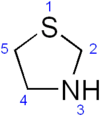Thiazolidine
Thiazolidine is a heterocyclic organic compound with the formula (CH2)3(NH)S. It is a 5-membered saturated ring with a thioether group and an amine group in the 1 and 3 positions. It is a sulfur analog of oxazolidine. Thiazolidine is a colorless liquid.
 | |
| Names | |
|---|---|
| IUPAC name
Thiazolidine | |
| Identifiers | |
3D model (JSmol) |
|
| ChemSpider | |
| ECHA InfoCard | 100.007.275 |
PubChem CID |
|
| UNII | |
CompTox Dashboard (EPA) |
|
| |
| |
| Properties | |
| C3H7NS | |
| Molar mass | 89.16 g·mol−1 |
| Density | 1.131 g/cm3[1] |
| Boiling point | 72 to 75 °C (162 to 167 °F; 345 to 348 K)[1] at 25 torr |
Except where otherwise noted, data are given for materials in their standard state (at 25 °C [77 °F], 100 kPa). | |
| Infobox references | |
Derivatives, thiazolidines, are known. For example, the drug pioglitazone contains a thiazolidine ring. Another drug that contains a thiazolidine ring is the antibiotic penicillin.
Preparation
Thiazolidine is prepared as it was in its first reported synthesis, by the condensation of cysteamine and formaldehyde.[2] Other thiazolidines may be synthesized by similar condensations. A notable derivative is 4-carboxythiazolidine, derived from formaldehyde and cysteine.
Derivatives
N-Methyl-2-thiazolidinethione is an accelerator for the vulcanization of chloroprene rubbers.[3]
Thiazolidines functionalized with carbonyls at the 2 and 4 positions, the thiazolidinediones, are drugs used in the treatment of diabetes mellitus type 2. Rhodanine is a related bioactive species, featuring one carbonyl and one thiocarbonyl.
See also
References
- Thiazolindine
- Ratner, Sarah; Clarke, H. T. (1937). "Action of formaldehyde on cysteine". Journal of the American Chemical Society. 59: 200–6. doi:10.1021/ja01280a050.CS1 maint: uses authors parameter (link)
- Rüdiger Schubart (2000). "Dithiocarbamic Acid and Derivatives". Ullmann's Encyclopedia of Industrial Chemistry. Weinheim: Wiley-VCH. doi:10.1002/14356007.a09_001.